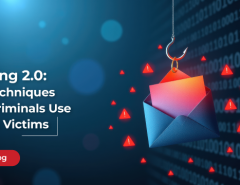Endpoint security is the front line in the fight against cyber attacks. Most of the attacks on organizations can be traced to a source that is external to the network i.e. the attack originates from something connected to the enterprise network. Which in turn means it comes from an endpoint.
What is an endpoint?
In a conventional sense, an endpoint is a device capable of sending and receiving data. Endpoints include any mechanism to connect to a network including LAN port, Wi-Fi, Bluetooth or any other technology. Laptops, computers, tablets, phones are all endpoint devices. Technically speaking, even the modem, hubs, switches, bridges, printer and external hard drives are all endpoint devices. They are capable of transferring data in either direction.
From a security perspective an endpoint device could be a laptop, a tablet, a home computer or a mobile phone on the edge (periphery) of the network that connects to the central network. With workforce getting mobile, increasing collaboration between partners and increase use of cloud, the number of endpoints today is much larger than that in the desktop era and it is increasing exponentially. The security of these endpoints becomes crucial when it comes to securing the enterprise against cyber threats.
Key factors affecting Endpoint Security
Here are a few factors that should be considered while deploying the endpoint security:
Comprehensive control: The security solution must provide comprehensive control across various endpoints . For this, it is necessary to understand the nature of endpoints that your network connects to. Identity management, network access, Port Control (including physical ports), Application access, Encrypted data management are the minimum controls that should be implemented. There will always be an exceptional requirement for business needs. Strong exception management is also important for any comprehensive control.
Centralized management: As the business grows, the network will also increase. The number of endpoint devices will spread geographically. At the very least there will be a cloud, home offices, and mobile devices along with internal devices that will need to be managed. There may not be a single solution to handle each one of them. Having separate management interface for each one can become a nightmare. A security solution that is centralized, easy to implement and scale up will add to the organization’s capability to manage its security.
Bolster awareness: Your enterprise’s security starts and ends with employees. If employees do not make mistakes, do not leave files open and unsecured on their desktops, do not connect to untrusted Wi-Fi and do not install dangerous apps or copy music and movies on their work devices, the life of CISOs would become easy. However, this is not the case. Employees must be educated about secure practices. Regular training, awareness sessions and if need be, strict policies should be enforced to ensure that employees follow safe practices.
Endpoint security is critical in securing the enterprise network. However, it is not as simple as disabling all endpoints. It needs careful planning, evaluations and achieving maturity within IT capabilities to get optimum balance between security and utility of network endpoints. Seqrite EPS is a power packed tool that provides robust endpoint security to organizations. Loaded with state-of-the-art features, Seqrite EPS is the answer to all CISO worries.
As an IT security partner for your business, Seqrite provides comprehensive endpoint security from advanced cyber threats. To know more, visit our website or




